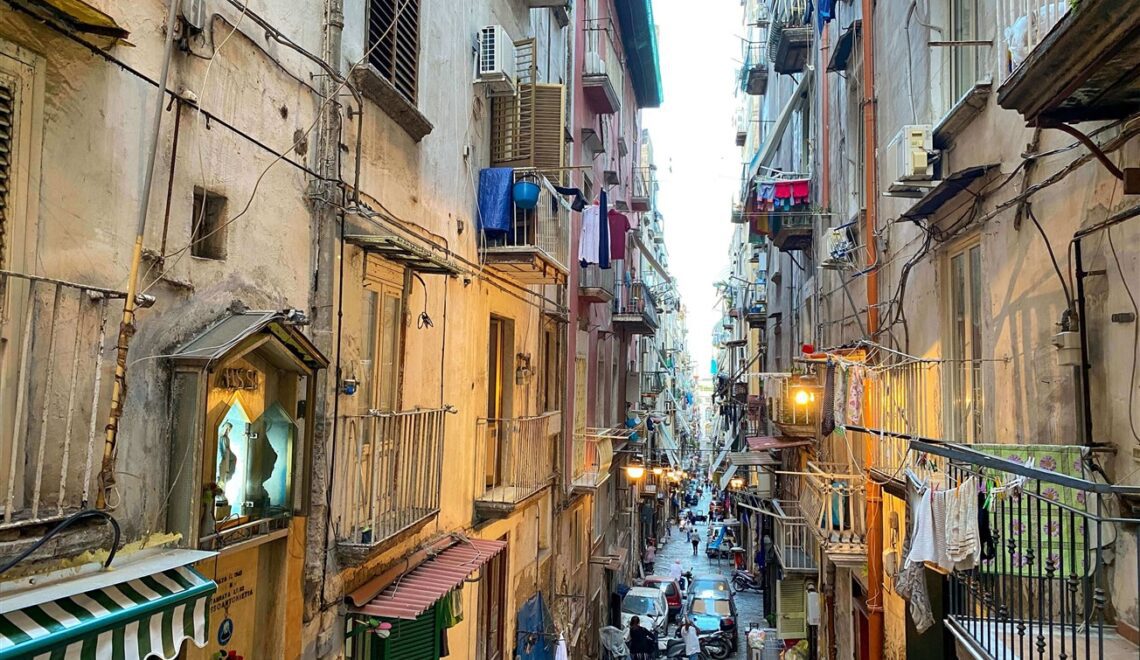
The Spanish Quarters area in Naples is so vast that it occupies no less than three municipalities: San Ferdinando, Avvocata and Montecalvario. It is an obligatory stop for any Neapolitan who wants to move from the Vomero hill towards the city centre, and can be easily reached by tourists, being close to via Toledo, Naples’ main commercial artery.
The Quartieri Spagnoli “Spanish Quarters” owe their name to the fact that they were created around the 16th century to accommodate the Spanish troops stationed in Naples. What should have been a temporary encampment was transformed over the centuries into one of the most densely populated areas of the city.
It was the Spaniards who turned this area into a place of perdition and underworld where soldiers came to seek entertainment and where numerous crimes were committed. The reputation as an area to be avoided continued for a long time, but today the Spanish Quarters of Naples are undergoing a great renaissance, thanks also to the presence of numerous associations operating in the area. This is demonstrated by the ever-increasing interest of tourists, who choose to delve into its intricate network of narrow alleys, and of real estate investors, who sniff out the area’s potential.
What to see in the Spanish Quarters in Naples
Starting from Via Toledo, it makes little difference which alleyway you enter to begin your visit. One way in is usually by the Toledo underground station, but you can choose whichever is more convenient for you.
The only way to really get to know the Quartieri Spagnoli is to get lost in its alleys and watch life go by slowly. I myself, when I decide to take a tour to take some photographs, never follow a predefined itinerary. You will immediately notice the typical “bassi”, i.e., the houses, craft shops, and establishments that overlook the street. Clothes hung from building to building over your heads, wooden baskets lowered from balconies to haul up the groceries. The custom of votive shrines, symbols of devotion to the Virgin Mary that light up the streets at night, is still alive. All images of an intriguing and fascinating Naples.
Who knows how many stories are hidden behind the faces of young and old who live around here. Stories of redemption and revenge.
In vico Lungo Gelso, in the time of the Spanish, prostitutes lived. They had been relegated to this alley covered with mulberry trees, hence the name, by the Spanish viceroy who did not want to see them wandering around the city. Today the prostitutes are no longer there but the charm of a street full of history and murals remains. It is precisely the murals, more or less large, that cover many buildings in the neighbourhoods. The most famous is the one dedicated to Diego Armando Maradona, in Via Emanuele de Deo, created in 1990 by the artist Mario Filardo on the wall of a six-storey building. If you look closely, Maradona’s head coincides with the window of a flat.
Not far away, there is the mural of Pudicizia, created by Argentine designer Bosoletti, which is a reproduction of the work in the Sansevero Chapel.
How can we forget the many trattorias that lurk in these alleys, where you can sample traditional Neapolitan dishes: from mussel soup to simple spaghetti with cherry tomatoes and basil, desserts like sfogliatella or babà. If you feel like an aperitif, then you will find someone who will sell you a Spritz for just 1 euro.
Are the Spanish Quarters dangerous?
This is one of those hateful questions I am asked most often but it is only fair to clarify. The Spanish Quarters are no longer as dangerous as they used to be but, as in any city in the world, it is right to behave discreetly and avoid walking around with flashy jewellery. This, however, is a rule that should apply everywhere and not only in Naples. Also, beware of mopeds whizzing by on all sides. They could pose a danger.












